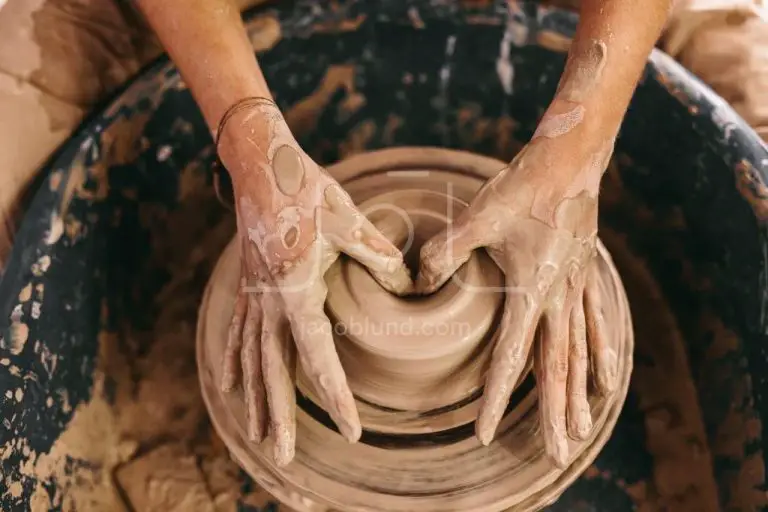What Are The 4 Main Properties Of Clay?
Clay is a fine-grained natural material that is an important component of soil. It is composed primarily of hydrated aluminum silicates, usually containing other minerals and organic matter. There are four key properties of clay that give it unique behaviors and make it so useful:
Plasticity – Clay is plastic meaning it can be molded and shaped, especially when wet. This allows it to be worked and formed into various shapes.
Cohesiveness – The particles of clay have an electromagnetic attraction to each other known as cohesion. This gives clay strength and forms a sticky mass when wet.
Adsorption – Clay readily adsorbs cations and other polar molecules such as water, as well as organic materials. This gives it excellent adsorption properties.
Shrinkage – As clay loses moisture it shrinks, developing cracks. The amount of shrinkage depends on the type of clay. These unique shrinkage characteristics are utilized in clay applications.
In the following sections we will explore these four key properties of clay in greater detail.
Plasticity
One of the most important properties of clay is its plasticity, which refers to the ability of clay to be molded or shaped without cracking or breaking apart. This makes clay an ideal material for pottery and ceramics, as it can be shaped into complex forms without losing its structural integrity.
The plasticity of clay is possible because of its chemical structure. Clay particles are flat and plate-like in shape, which allows them to slide over one another when a force is applied. However, the particles also carry electrical charges that cause them to stick together at the same time. This combination of sliding and sticking gives clay its unique plastic behavior.
Clay can be molded when wet, allowing potters and artists to form vessels or sculptures by hand or with basic tools. As it dries, the clay holds its new shape. Firing permanently hardens the clay body while retaining the form. Without plasticity, clay could not be used to create intricate pottery shapes and designs.
The specific level of plasticity depends on the clay mineral composition and presence of non-clay particles or organic matter. Some clays are very short and crumble easily when worked, while others are extremely plastic and can almost be bent into shape. Potters often blend different clays to achieve the ideal malleable properties.
Plasticity makes clay a versatile, workable medium for artistry and craftsmanship. The moldable nature of clay has enabled human civilization to make use of this abundant material for millennia, from simple earthenware pots to ornate decorative ceramics.
Cohesiveness
One of the key properties of clay is its cohesiveness. This refers to the ability of clay particles to stick together when wet. Due to their platelike shape and tiny size, clay particles have a large surface area relative to their volume. This allows water molecules and other polar molecules to adhere to the surface of the clay particles via hydrogen bonding and van der Waals forces.
When clay is mixed with an appropriate amount of water, these adhesive forces cause the clay particles to cling together and form a malleable, plastic mass. The extent of cohesiveness depends on the specific clay mineral composition, but in general clay becomes increasingly sticky and moldable as more water is added.
It is this cohesiveness of wet clay that allows it to be shaped and molded into pots, bricks, tiles, and other useful objects. The clay maintains its molded shape as long as the object is kept wet. When dried, the water evaporates but the clay particles remain stuck together in the hardened shape.
So in summary, the cohesiveness of clay arises from the surface interactions between tiny clay particles suspended in water. This makes wet clay moldable like a plastic but allows it to harden into shapes when dried out.
Adsorption
One key property of clay is its ability to adsorb molecules and ions to its surface. Clays have a net negative surface charge, which attracts positively charged ions and molecules. When these substances come into contact with clay surfaces, they adhere onto the surface through weak electrostatic forces in a process known as adsorption.
The adsorptive capacity of clay depends on several factors. Clays with smaller particle sizes and more surface area have greater adsorption capabilities. The type of clay mineral also matters, as different clays have varying surface charges and reactive sites. Montmorillonite clay, for example, has a high surface area and charge, making it very adsorptive. The pH of the surrounding environment can also impact adsorption.
Adsorption is responsible for many important properties of clay. It allows clay to remove positively charged organic compounds and heavy metals from water through purification processes. Adsorption also assists in retaining water and nutrients in soil. The adsorption of organic compounds gives clay its distinctive smell. Overall, the adsorptive nature of clay has numerous chemical, environmental, agricultural, and industrial applications.
Shrinkage
When clay dries, it undergoes shrinkage or volume reduction. As water evaporates from the clay, the clay particles become closer together causing the bulk clay to shrink. Different types of clay shrink by different amounts based on their composition. In general, clays with higher plasticity and higher amounts of expansive clay minerals like smectite and vermiculite will shrink more.
As the clay shrinks, stresses build up within the drying clay body. If these stresses exceed the strain capacity of the clay, cracks will form to relieve the stress. The formation of cracks is influenced by how fast the clay is dried. If dried slowly under controlled conditions, a clay body can shrink without cracking. But if dried too quickly, cracks will develop.
The shrinkage cracks that form during drying can be a nuisance during ceramics processing. Special drying controls are used to minimize cracking. In other applications like liners for ponds and landfills, the shrinkage cracks are a major concern because they compromise the barrier integrity. Engineers must design clay liners accounting for the shrinkage and potential cracking that will occur as the clay soil liner is exposed and dries out.
Hardness and Strength
Clay demonstrates varying levels of hardness and strength depending on its composition and whether it has been fired. When clay is exposed to high temperatures through firing, clay particles fuse together in a process called sintering. This causes the clay to harden as it vitrifies. The degree of hardness depends on the temperature and duration of firing. Higher firing temperatures result in harder clay with higher strength.
The specific mineral composition of clay also affects its potential hardness and strength. Clays with higher amounts of flux materials like feldspar begin to melt and fuse at lower temperatures, enabling harder vitrification at lower fire temperatures. Clays high in kaolinite require higher firing temperatures to achieve vitrification and maximum hardness. Additionally, some clays contain impurities that can weaken the fired body if not carefully controlled during firing. Optimal firing conditions must be used to achieve the highest potential hardness and strength of any clay body composition.
Pore Water
One of the most important properties of clay is its ability to hold water in the spaces between the clay particles, known as pore water. This water can move in and out of the pores as the moisture content of the soil changes.
Clay particles are flat and plate-like in shape. When clay particles are packed together, the plates overlap and stack together leaving tiny spaces in between. These nanometer-sized spaces act as pores that can fill with water.
The pore water is held in the clay by capillary action and adhesive forces between the water and clay particles. However, it does not become part of the clay’s crystal structure. The pore water can be lost from the clay through evaporation and drainage.
The amount of pore water influences many engineering properties of clay including its strength, compressibility, and permeability. With an increase in moisture content, the cohesive bonds between clay particles weaken as the water lubricates the particles and pushes them apart. This results in a loss of strength.
Understanding the behavior of pore water is critical for building on clay soils. The change in volume as pore water content changes leads to shrinking and swelling of clay that can damage foundations and roads. Controlling moisture content is key for construction on clay soils.
Cation Exchange Capacity
One important property of clay is its cation exchange capacity (CEC). This refers to the ability of clays to adsorb positively charged ions (cations) and exchange them for other cations in the surrounding soil environment.
The CEC of clay is attributed to its net negative surface charge, which attracts the positive cations. The most common exchangeable cations found in soils are calcium, magnesium, potassium, sodium, and hydrogen.
Clay’s CEC contributes greatly to soil fertility, as it provides a reservoir of available nutrients for plants. The cations held on the clay surfaces can be gradually released and absorbed by plant roots as needed. A soil with higher clay content will have a higher CEC and be able to retain more nutrients.
Clay minerals such as smectite and vermiculite have very high CEC, while kaolinite has a lower CEC. The specific CEC of a clay depends on the structure and surface area of its mineral crystals.
Due to its cation exchange capacity, clay plays a crucial role in soil’s ability to store and supply essential nutrients for plant growth. This makes it a very important component of productive agricultural soils.
Uses of Clay
Clay’s unique properties make it incredibly versatile, allowing it to be used in a wide range of applications. Some of the most common uses of clay include:
Pottery
Clay is the primary material used in pottery and ceramics. When clay is fired in a kiln, its melting point is reached and it becomes permanently hard. Clay can be shaped into pots, vases, sculptures, tiles, and other objects. Different clay minerals produce pottery with varying properties when fired.
Bricks
Clay bricks have been used as building materials for thousands of years. Modern bricks are often made by pressing clay in molds before firing them. The heat hardens the bricks so they can be used for construction. Clay bricks are durable, fire resistant, and effective for thermal insulation.
Paper
The production of paper often utilizes clay as a coating and filling material. Clay coatings can make paper brighter, smoother, and more opaque. Clay is also used as filler to improve the paper’s thickness and opacity. Certain clays can improve printability, ink absorption, and durability of paper products.
Cosmetics
Clays such as bentonite and kaolin have absorbent properties that make them useful ingredients in cosmetics. Clay masks can remove impurities and absorb excess oils from skin. Clays help purify and nourish skin while imparting beneficial minerals. Various colored clays are also used as pigments in makeup.
Pharmaceuticals
Due to their high specific surface area and absorption capacities, clay minerals are utilized as excipients in pharmaceutical products. Clays can help deliver active ingredients, extend release times, and improve tablet-binding capabilities. Certain clays also exhibit bactericidal effects. Montmorillonite clay is sometimes used for detoxification remedies.
Conclusion
Clay is an important material in our everyday lives. This article summarized the four key properties that make clay so useful: plasticity, cohesiveness, adsorption, and shrinkage. Plasticity refers to the ability of clay to be molded into different shapes, while cohesiveness allows clay particles to stick together. The adsorption property gives clay the ability to adhere to other materials and absorb substances, while shrinkage allows clay to reduce in volume as water content decreases. These special properties allow clay to be shaped into bricks, pottery, ceramics, and other products that have been essential to human civilization for thousands of years. The small size of clay particles, and their plate-like shape, give rise to the unique surface chemistry that produces these special properties. As our reliance on natural materials continues, an understanding of clays and their characteristics will remain important.


